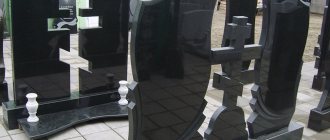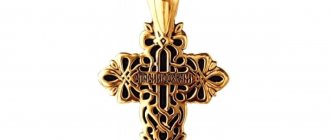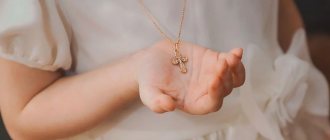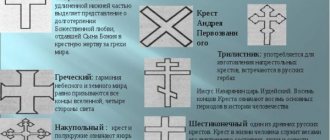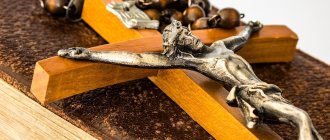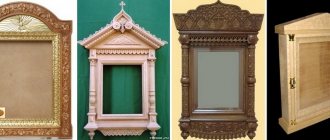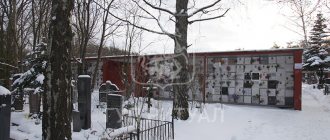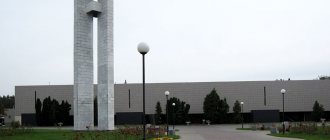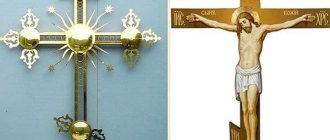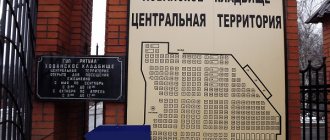Why do they always put a cross on the grave after a funeral?
An eight-pointed cross is placed on fresh graves in the projection of the deceased’s feet. According to historians, its shape completely corresponds to the cross on which Jesus Christ was crucified. According to the generally accepted tradition, a cross is placed on the grave where the face of the deceased Christian is directed, and Orthodox Christians are usually buried facing east. But there are no official recommendations from the church regarding the location of the cross in the cemetery.
Some believe that the soul, leaving the earth, kisses the tombstone crucifix, expressing its submission and belonging to Christianity, but there is no evidence of this, and Orthodox priests are completely skeptical about such superstitions. It is necessary to place a cross on the grave of an Orthodox Christian, but it is not worth ascribing various esoteric meanings to this ritual. The only suitable explanation for the tradition: during life, a Christian wears a cross around his neck, he is buried with sacred images, and a crucifix is placed on the grave as a sign of belonging to Orthodoxy.
The tombstone cross weighs little and does not interfere with the natural subsidence of the earth at the burial site during the first year after the funeral. It can be ordered from a funeral company, purchased from a church for a donation, or made with your own hands.
What should a cross be like: appearance, materials
Orthodox Christians venerate different types of crosses, but at burials it is preferable to place eight-pointed crosses with an oblique crossbar. This is due to the fact that this form was used during the crucifixion of the Savior. If it is not possible to purchase or make an eight-pointed cross, it is permissible to put up six-pointed crosses. Four-pointed crosses are already considered Catholic and are not suitable for Orthodox burials.
There are also so-called crosses “with a roof” - but these solutions are used in Old Believer burials; they have nothing to do with traditional Orthodox Christians.
Decoration of an Orthodox cross in a cemetery
A grave cross made of wood, which is installed immediately after the burial of a person, can be simple or have any additional decorations. It is made from solid wood (usually pine). Crucifixes can be decorated:
- ornament in the form of carvings;
- Christian icons;
- dominami;
- superimposed figures of Christ and the Virgin Mary;
- inscriptions on wood;
- metal plaques with the name of the deceased and his years of life.
The crucifix is temporary, so there is no point in spending a lot of money on its decoration. It can only be varnished in several layers, allowing each layer to dry thoroughly, or painted with special oil paint or wax. They protect the tree from ultraviolet radiation and harmful insects. Also, an oil coating protects wood from the formation of harmful microorganisms in it, and a wax coating repels water.
In order not to change the appearance of the wood, you can use stain. It penetrates the wood structure, forming a thin film, protecting the wood from insects. The stain contains non-leaching and non-evaporating biocides.
But, according to the clergy, a proper Orthodox cross on a grave should not have any excesses or decorations. The crucifix is only a material embodiment of memory, and the burial place does not need to be turned into an altar.
Is it possible to change a grave cross?
A temporary grave cross installed on the day of the funeral must be replaced over time. As a rule, this is a wooden cross, which, due to the properties of the material, is not particularly durable.
Despite the fact that an Orthodox grave cross made of wood is treated with modern means that prevent decomposition or the action of insects, over time it becomes unusable. In the best case, it can last up to 10 years, but in practice, much less.
The temporary cross is replaced with a permanent one, stone or metal. If the decision is made to erect not a cross, but a tombstone and monument, it must necessarily contain an image of a cross.
Dimensions of a wooden cross for a grave
The eight-pointed cross consists of four crossbars, each of which has a special sacred meaning. Their arrangement corresponds to the famous golden ratio or human proportions. Based on this, the standard dimensions of an Orthodox cross are approximately as follows:
- the size of the long longitudinal crossbar is 1.618 meters;
- the length of the crossbar at the top of the cross is 0.382 meters;
- the distance between two transverse bars is 0.236 meters;
- the distance from the oblique crossbar (foot at the bottom) to the ground is more than 0.5 meters.
But a cemetery cross can have any height and width. Even placing a small crucifix on a burial mound is not a violation. However, it must be proportionate to other accessories in the cemetery plot.
The size and weight of the crucifix determine how it will be installed on the grave. Tall massive products require additional work to strengthen the structure.
Parameters of cross elements
The height of the product (after installation) corresponds to the average height of a person - about 1.7 meters. A third of this length is the main cross bar, and the rest should be shorter. The angle of the inclined board is up to 45 degrees. These proportions do not have precise explanations; rather, they are formed according to the principle of harmony. Products with similar proportions look more familiar and beautiful.
Drawing of an Orthodox cross with dimensions. Click for full size image.
What to do if a cross falls on a grave
Floods, hurricanes, heavy rains and other climatic anomalies can cause the grave cross to fall or tilt. A simple wooden structure is installed on a burial mound without a foundation or various reinforcements, so it can easily warp even due to minimal outside influence.
If the cross is skewed, it must be corrected and compacted into the ground so that the crucifix stands straight. After decorating the grave, it is also recommended to order a prayer service for the repose of the deceased and light a candle for him in the temple. There is no need to perform any additional rituals.
Is it possible to remove a cross from a grave and how to dispose of it?
The cross is allowed to be removed due to destruction and if it needs to be replaced with a monument. And here there are several rules:
- If there is no image of a cross on the monument, such a product will not be rejected. The cross itself is simply placed behind the monument.
- When the desired image is provided on the monument, the cross does not need to be left.
- It is important to dispose of unwanted products correctly. Wooden structures are dismantled and burned. If we are talking about metal, then the cross is sawn into pieces, which are buried in the burial area.
You need to handle the Orthodox symbol, which means a return to eternal life, carefully. Do not take the unnecessary cross to a landfill or simply throw it away. This will be disrespectful both to the faith and to the deceased himself. Moreover, the rules for installing and disposing of crosses are simple.
Author Esipov Valery
What to do with a wooden cross when installing a monument
A year after the funeral, the relatives of the deceased usually erect a monument on the grave: where the wooden cross is already located. When installing a new tombstone, you can not remove the old crucifix, but place the monument on the opposite part of the grave, i.e. over the head of the deceased.
If, when installing a tombstone, the cross is nevertheless dismantled, it can be given to a workshop at the temple (if it is well preserved) or burned, having previously obtained permission from the cemetery administration. There are special areas for making fires in every cemetery. But under no circumstances should you throw an old crucifix into the trash.
How crosses are made for graves
For work they use different drawings, standard and original. The easiest way to make a crucifix is from wood or by welding iron. Welded artistic elements are attached to the iron product, and carvings are made on the wooden product.
Not every wood is suitable for work. Use:
- bog oak;
- ordinary oak;
- pine;
- aspen;
- cypress;
- teak;
- Iroko.
Making an iron cross takes less time. A wooden one, made according to all the rules and decorated, can take up to 5-6 months, and even longer for granite and marble ones.
Crucifixes made of cast iron, marble and granite chips are often made by casting: hot metal or a special mixture with crushed stone is poured into a special mold, allowed to cool, and then polished, engraved, and treated with special coatings.
Permanent crosses in the cemetery
Instead of a monument, you can install a cross made of high-quality wood, metal, marble or granite on the grave. It is placed as a replacement for a wooden crucifix. In fact, the material for a permanent cross can be anything.
The only exception is aspen. According to legend, Judas hanged himself on it, which is why this tree is considered cursed. You cannot use aspen to make an Orthodox cross. The installation of a permanent cross on a grave can be done independently, but it is better to involve a ritual office for this purpose.
Metal cross
Metal crosses are made from welded profile pipes or from metal by forging. Most often, structures are made of stainless steel: such crosses are inexpensive and look decent. If different alloys (iron, copper, etc.) are used in the manufacture of the tombstone, this will increase its final cost.
HOW AND WHERE TO ORDER A CROSS WITH EXACT SIZES?
You can buy tombstones with a cross (see photos in the photo gallery) here on our website. Just click on the model and send it to the cart.
You can place an order and sign contracts in our office. If you are busy, then order. He will come to your home or work at the appointed time (Moscow and the nearest Moscow region).
You can order an exclusive granite Orthodox grave sign; its price is slightly higher than regular models. Show your drawing (sketch, photo) to our designer. It will create a 3D image, and you will see an exact image of the future product. After making corrections and agreeing on all the details, your order will be processed and completed within the agreed time frame.
What does the cross symbolize in the feet and in the head?
In accordance with Orthodox traditions, a crucifix is placed at the feet. The position of the coffin in the grave is as follows - the side of the legs is placed to the East, and the side of the head to the West. This is how Christ is believed to have been buried. The scriptures say that if the world suddenly ends, it will rise again. Jesus will rise from the East, and all the dead will follow him. At the Last Judgment, the rebels will see Christ, and in their hands there will be support from the cross. Therefore, the crucifix is called a symbol of support and eternal life.
A cross mounted on the head of the deceased can mean a banner. He will carry it after the resurrection, as a sign of victory over the dark forces. This is how Catholics put the symbol. According to their tradition, on the day of the resurrection of all the dead, the cross, like a banner, will become a weapon in the fight against the devil.
Location in the legs
The Church does not consider the location of the symbol on a grave to be any church law. This refers rather to Orthodox traditions and local customs. Where to place it is decided by the relatives of the deceased, taking into account their beliefs and wishes of the deceased, if it was said during life.
There are disagreements among priests on the issue of where Orthodox Christians place a cross on the grave of the deceased. If in the sacred book “Everyone is Alive with God” it is said that the crucifix rises above the burial of any Christian, as a symbol of salvation and he stands at the feet of the buried, then in another book by the priest monk Nikolai Trubchaninov it is said that he is ready to accept the most cruel torments, but, so that a crucifix would be installed in his head on his grave.
Some clergy believe that the cross at the head will prevent the dead from rising from their graves during the general resurrection. They will simply hit the ground and not be able to get up. But those who have a crucifix at their feet will be able to lean on it and be resurrected.
Thus, the cross at the feet of the buried person is a symbol of spiritual support and eternal life. This is the whole reason for placing the symbol at the feet of the deceased who professes Orthodoxy.
Material
Of course, a good wooden cross can stand on a grave for generations, however, most likely, after a few decades it will become askew and possibly fall - the proximity of damp soil is unfavorable for wood.
It is best if the cross is made of other materials - for example, stone or metal. True, metal crosses do not look, to put it mildly, the most aesthetically pleasing if they represent the only tombstone structure - since in this case they have to be hung with signs with names, dates and photographs.
Crosses made of gabbro-diabase, granite and marble or forged products definitely benefit in this regard: they can be made wide enough to engrave dates and inscriptions directly on them.
Is it possible to replace a rotten or broken cross?
If the crucifix has become unusable, it is replaced with a new one. In this case, the wooden product must be burned.
If it is made of a different material, there are three options:
- give to those who do not have the money to order their own;
- divide into parts and bury next to the burial;
- take it to a chapel or temple;
- leave it within the cemetery near the fence.
Taking a crucifix home, using it for household needs, or throwing away the traditions of Orthodoxy is not directly prohibited, but such treatment of the symbol of faith is condemned.
“Question-answer” section
Why is the cross askew, can it be corrected?
Expert opinion
Klochkov Andrey
Employee of the improvement department of the municipal unitary enterprise "Clean City"
There are various superstitions among people, but when changing the position of the cross on a grave, only one factor needs to be taken into account - a change in the properties of the soil. When the crucifix was installed improperly, sealing materials were not used, or the ritual attribute turned out to be too large or heavy, the soil will sag more intensely. As a result, the crucifix is askew, but it is not prohibited to correct it, since a deviation from the vertical of several centimeters is very noticeable.
Is it possible to leave a cross on a grave with a monument?
Expert opinion
Klochkov Andrey
Employee of the improvement department of the municipal unitary enterprise "Clean City"
According to modern tradition, the cross installed after the funeral is dismantled. But Orthodox canons even earlier required the placement of a new tombstone without removing the crucifix. Moreover, it is permissible to choose any of the options: the monument was placed at the feet or at the head of the deceased. Then in the first case it was located next to the cross, and in the second - opposite.
On the grave there is a cross with a monument
Why are roofs built on crosses?
Expert opinion
Klochkov Andrey
Employee of the improvement department of the municipal unitary enterprise "Clean City"
The structures were called “cabbage rolls” and had a mystical meaning - associated with the habitat of spirits. In addition, such a structure was popularly considered a house for the deceased, and it also protected icons, which were previously attached to wooden crosses, from precipitation. But recently, such structures have ceased to be used - they were banned by the church as a manifestation of paganism.
Is it possible to attach a photograph of the deceased to a cross?
Expert opinion
Klochkov Andrey
Employee of the improvement department of the municipal unitary enterprise "Clean City"
It is permissible to place a tablet on a crucifix with the information of the deceased. But it’s better to put the photo at the base. This is due to the fact that during prayer a substitution of values occurs - the deceased is raised to the level of Christ, since his face is located in the same place as the crucifix. Such an appeal to God can have a negative meaning - a person concentrates on worldly things, elevates earthly things above the Lord, and this is a sin.
Cross on a monument: which side is it placed on?
Expert opinion
Klochkov Andrey
Employee of the improvement department of the municipal unitary enterprise "Clean City"
An engraving or protruding decorative element can be placed where the composition requires it. This is what many people think today. However, the priests say that the ritual attribute should be on the right, because on this side is God, and on the left is the Devil. However, when looking at the monument, in this case the image will still appear on the opposite side, since the viewer is opposite. Others advise paying attention to the height of the engraving - the crucifix is applied to the surface of the structure higher than other elements.
Four-pointed Catholic cross on the grave
What are the dimensions of a metal grave cross?
Expert opinion
Klochkov Andrey
Employee of the improvement department of the municipal unitary enterprise "Clean City"
The dimensions of ritual attributes are standard: the same as for wooden and stone products. But there are some recommendations that will help you navigate when determining the lengths of the sides: side planks - 1/3 of the height, lower part - 2/3 of the entire structure, lower inclined plank - at an angle of 45°.
What to do with the cross after installing the monument?
Expert opinion
Klochkov Andrey
Employee of the improvement department of the municipal unitary enterprise "Clean City"
You cannot throw it into a landfill, as this will be considered trampling on the shrine. It is better to burn the wooden crucifix. An alternative is the dismantling option - the crucifix is dismantled into pieces and then buried at the base of the grave. The photo of the deceased left after the funeral is burned.
How to make, paint and install a wooden cross with your own hands. Drawings download for free
To make a wooden cross, you need to create a drawing. It is better not to make ritual attributes at your own discretion; you can download a ready-made diagram, since it is important to maintain the ratio of the side lengths. First, it is proposed to make a simple cross; for this, bars are cut and processed. Before installation, the product is coated with protective compounds. Place the cross in the hole. Clay is used to backfill it, because it does not wash out, does not sag over time, and is highly dense. But the hole in the ground is first filled with stones to increase the reliability of fixation of the installed structure.
Drawing for making an Orthodox wooden cross
